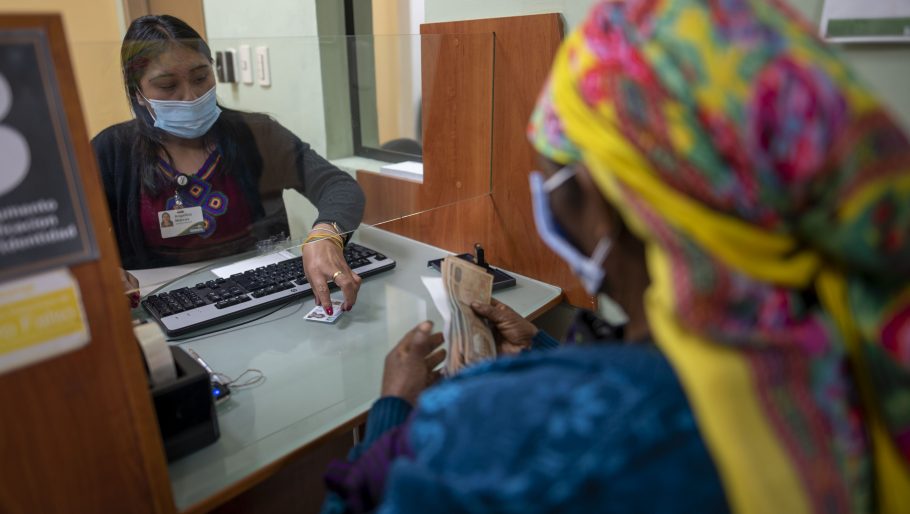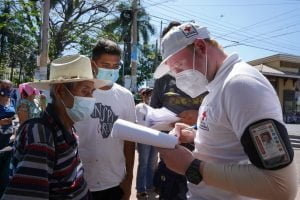Ready to use cash in preparation for crisis?

What can we learn from programs that have used humanitarian cash and voucher assistance (CVA) in social protection programs to prepare communities for crisis? Looking at Latin America and the Caribbean specifically, how can this multi-hazard prone region benefit from its strong history of using CVA for improved disaster preparedness? The CALP Network commissioned a study to answer those questions. Madison Chapman was the lead consultant on the study, and here she shares her thoughts on what she learned.
Extensive coastlines, warming temperatures, political turnover and social unrest, migration, extreme poverty, and frequent hurricanes and drought make Latin America and the Caribbean (LAC) a vulnerable region. The region is no stranger to shocks, whether climate-related, social, or epidemiological. From Hurricanes Eta and Iota, the Volcán de Fuego eruption to continued migration surges and the recent COVID-19 response, the region has had to adapt and to adapt rapidly. A key part of this adaptation has been to strengthen the use of social protection systems and programming as part of the response when shocks occur.
In LAC there is extensive experience in using CVA in social protection, but there is scant evidence around linking it to preparedness and humanitarian CVA. CALP commissioned this study to map the experiences of humanitarian CVA used for preparedness in social protection to date in this region and explore barriers, enablers, challenges, and opportunities in relation to better linking of social protection and CVA in LAC. The study found a range of different initiatives spanning government, humanitarian and development actors and local organizations. Honduras and the Dominican Republic were used as case studies for a deeper dive into these issues.

The deep dive: Countries like the the Dominican Republic, El Salvador, and Honduras have been trailblazers. For example:
The Dominican Republic is developed emergency “top-ups” as part of an Emergency Preparedness Plan that allows for the automatic redirection of social protection funds to disaster-affected communities at the onset of an emergency and has also worked with UNICEF to adjust assessments to better capture households with children with disabilities. Honduras is investing in transparency through self-registration and information-sharing platforms, as well as deeper coordination with the national Cash Working Group. El Salvador worked with the World Food Programme to establish common regional response standards for chronic droughts. This included standardizing transfer amounts by region within the country, collaborating with El Salvador’s Civil Protection ministry to determine most-affected areas, streamlining targeting criteria, developing delivery mechanisms through the national bank, and linking social registries across government ministries to create a single, uniform registration platform. These activities not only strengthened government preparedness for CVA in social protection, but also open the door for more effective monitoring, evaluation and learning.
Strengthening humanitarian CVA and social protection linkages for disaster preparedness: What is needed?
Governments that are open and have experiences to build on:
The COVID-19 pandemic offered an opportunity to pilot the use of the CVA in new ways and drew on the expertise of different actors. Many governments in LAC have demonstrated an openness to experiment with the use of humanitarian CVA (El Salvador), engage non-governmental organizations and the United Nations to use existing programs (Dominican Republic), seek out technical support (Honduras), and learn from Cash Working Groups to design new programming (Guatemala).
Legal reform:
This may be one of the most important areas for reform. Current laws and mandates often block rapid and flexible response. Additionally, having at least one national ministry with the legal remit to use humanitarian CVA for preparedness and to coordinate with others would be a major step forward. This would also help to institutionalize technical knowledge and make humanitarian CVA in social protection more sustainable in the face of frequent government turnover and political change. Overcoming legislative barriers may sometimes require constitutional reform or mandate change to allow social protection ministries to adopt a humanitarian mandate.
Better coordination:
Preparedness is multi-faceted and does not exist in a vacuum. Strong preparedness for humanitarian CVA in social protection depends on coordination between humanitarian and development actors along with government, including Non Governmental Organzations the, the United Nations, and possibly regional organizations.
Financing:
Strong preparedness for humanitarian CVA in social protection depends on adequate financing for events that may not occur. There is an obvious role for donors—humanitarian and development—in funding and investing in preparedness as an anticipatory action. This can be through both humanitarian CVA, linking humanitarian CVA with social protection programs and/or systems and through making existing social protection systems more shock responsive.
Political will and public messaging:
These are essential to support such financing, especially from donor governments. Preparedness in Mexico, Central America, and the Dominican Republic also revolves around equity, transparency, and accessibility of: delivery systems, or data management, of recipient identification, and of targeting. Digital and geographic divides continue to pose a challenge for CVA in LAC, while hesitancy to move from e-vouchers to unrestricted cash poses important questions about recipient choice and dignity.
How to achieve this change more broadly?

Better preparedness that draws on and brings together the best of both cash-and voucher-based systems – be they humanitarian or social protection – will require a re-imagining of the purpose of humanitarian CVA, and the goal of preparedness.
There are a number of key steps that governments can take to signal that preparedness is a top priority by: Working closely with Cash Working Groups, or embedding humanitarian CVA in national roundtables, technical accompaniment of government actors by NGOs and UN agencies and working to digitize and update registration and monitoring, evaluation and learning systems.
Governments in LAC can harness the momentum and growing capacity to work with civil society to catalyze this change. The region has got what it takes to make these changes. It was in LAC that governments pioneered social protection programs with CVA such as Mexico’s Progresa-Oportunidades-Prospera. Growing interest in preparedness with humanitarian CVA in social protection positions actors in the region lead the way in making social protection truly shock-responsive. The vibrant activity of civil society organizations will also be key to catalyze this change.
Are you interested in this topic and want to do more? We invite you to read the report and case studies (to be published soon), visit SocialProtetion.org for a wealth of resources, and share what you are learning and achieving in your contexts with the CALP Network.
About the author
 Madison is an incoming Foreign Affairs Officer with the U.S. Department of State’s Bureau of Population, Refugees, and Migration. She recently led a team exploring social protection, preparedness, and CVA in Central America, the Dominican Republic, and Mexico as an Independent Consultant with the CALP Network. Prior to that, Madison consulted on urban livelihoods, economic empowerment and gender equality, MEAL, and financial inclusion for CALP Network, Girls Not Brides: The Global Partnership to End Child Marriage, and Catholic Relief Services. Madison has regional expertise in Latin America and has previously conducted research in Colombia and Ecuador on livelihoods and financial integration in displacement. She holds an MA from The Fletcher School of Law and Diplomacy in Development Economics and Humanitarian Response, with a focus on gender equity, and a BA in Political Science from the University of California, Berkeley.
Madison is an incoming Foreign Affairs Officer with the U.S. Department of State’s Bureau of Population, Refugees, and Migration. She recently led a team exploring social protection, preparedness, and CVA in Central America, the Dominican Republic, and Mexico as an Independent Consultant with the CALP Network. Prior to that, Madison consulted on urban livelihoods, economic empowerment and gender equality, MEAL, and financial inclusion for CALP Network, Girls Not Brides: The Global Partnership to End Child Marriage, and Catholic Relief Services. Madison has regional expertise in Latin America and has previously conducted research in Colombia and Ecuador on livelihoods and financial integration in displacement. She holds an MA from The Fletcher School of Law and Diplomacy in Development Economics and Humanitarian Response, with a focus on gender equity, and a BA in Political Science from the University of California, Berkeley.
Main picture: In San Mateo, Guatemala people receive cash transfer assistance as part of the response to the sanitary emergency due to the COVID-19 pandemic in 2020. Credit: Carlos Alonzo/WFP.


